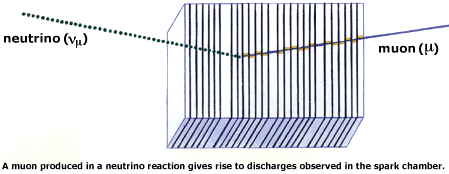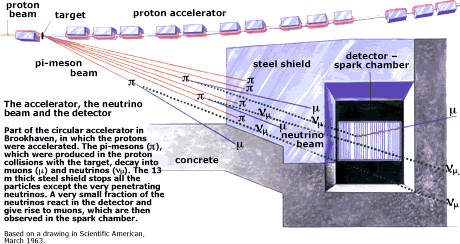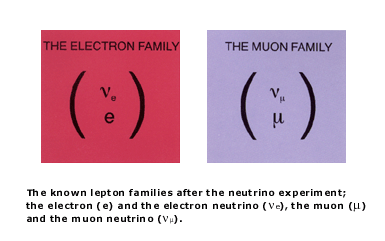The hunt for the muon neutrino
|
In order to understand how the weak force works and to explore the possible existence of two neutrinos, it was necessary to study neutrino interactions at high energies. Leon Lederman, Melvin Schwartz and Jack Steinberger were working to achieve a sufficiently intense neutrino beam for several years. This neutrino beam was produced in several steps: – Protons were accelerated to an energy of 15 GeV (1 GeV = 109 eV) in the Brookhaven accelerator AGS (Alternating Gradient Synchrotron) on Long Island, USA. – The intense proton beam was directed onto a target of beryllium. In each collision a handful of particles were produced, mainly pi-mesons. – The many pi-meson decays – The neutrinos, the muons and the surviving pi-mesons crashed into a 13 m thick steel shield, which stopped all particles except the neutrinos. The steel shield, which was made of armour plates from scrapped warships, was essential for the experiment. All particles, except the neutrinos, had to be prevented from reaching the detector, as they could give rise to a large number of particle reactions and completely swamp the incredibly few neutrino reactions. The pi-mesons, which interact through the strong force, were stopped after less than half a metre of armour plates, while the muons, which interact mainly through the electromagnetic force, penetrated much further. The steel shield, which had a weight of about 2000 tons, was dimensioned to stop the penetrating muons. The muon neutrino was discovered! The experiment of the Nobel Prize winners not only showed that the muon and the muon neutrino form a pair, it also showed that the other two leptons, the electron and the electron neutrino, form a pair. The grouping in pairs of elementary particles is fundamental in particle physics and became even more significant after the establishment of the so called standard model. |
||
 |
||
 |
||
 |
Nobel Prizes and laureates
Six prizes were awarded for achievements that have conferred the greatest benefit to humankind. The 14 laureates' work and discoveries range from quantum tunnelling to promoting democratic rights.
See them all presented here.
